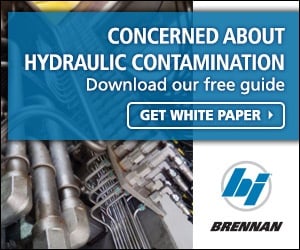There is a lot to consider for an effective hydraulic system maintenance program. Though hydraulics can be complex systems, it is best to keep the program simple, have a plan and follow it. Remember that hydraulic fluid and systems are dependent on each other, so it’s critical to ensure procedures are put into place for both.
A lack of hydraulic system maintenance is the primary cause of component and system failure. The basic foundation to perform proper maintenance involves two primary functions:
1. Preventive Maintenance
Preventative maintenance (PM) is crucial to maintaining the service life of equipment and reducing costs associated with unplanned equipment shutdown. This is particularly important when engaging in hydraulic system maintenance. Ignoring the hydraulics in a PM plan can cause catastrophic failure that may not be detected until it’s too late. A hydraulic fluid PM plan should follow the equipment and filter manufacturers’ recommended hydraulic maintenance schedules, take into consideration the working environment and use test points (see below) to draw samples from the line for fluid testing. Regular standards and procedures should be documented and adhered to for the proper maintenance of any equipment with a hydraulic system.
2. Corrective Maintenance
System components should be inspected during preventative maintenance to address any anticipated issue before failure occurs. Ideally the need for corrective maintenance can be identified and addressed in preparation for a scheduled or planned shutdown. Be sure any repair of components is performed properly. If not, issues may arise that can cause even greater harm.
If a component needs to be replaced before it’s anticipate life cycle, the reason should be documented in the PM plan and corrective measures put in place to eliminate having the issue occur in the future.
Monitoring of Hydraulic Systems with Test Points
Pre-installed test points should be placed at regular intervals along the fluid line to monitor system conditions. Test point quick couplings are used to monitor pressure, vent a system or draw fluid samples for testing. They provide easy access and are used to identify problems before they occur. The couplings connect quickly and easily to measurement, control and switching devices, providing leak-proof connections before the ball check is open to minimize contamination of the hydraulic system. A self-locking metal cap seals the fitting to further protect the system from the environment. It is best practice to have pre-assembled test pressure monitoring kits on hand at all times. These kits are available with everything required for instant pressure checking regardless of style of the OEM’s existing hydraulic systems.
Steps to Hydraulic System Care & Maintenance
1. System Care
The following are some of the basic steps to help keep equipment running smoothly, safely and avoid unplanned system failure:
- Monitor and control the temperature
- Keep the fluid clean
- Keep the system clean
- Have a standardized oil analysis program
Be sure to follow the OEM’s specifications for how often hydraulic oils should be drained. And do regular system monitoring with test point fittings and gauges to allow for accurate examination of the system.
2. System Maintenance
A good preventative hydraulic system maintenance schedule should have a multi-point process in place. The following are some of the more important steps to follow:
- Visually inspect pipes, hoses and pipe connections for leaks or cracks
- Listen for potential cavitation in the pumps
- Check fluid levels
- Inspect filters
- Check servo valves with an infrared thermometer
- Check system temperature
- Inspect fluid for irregular color, odor and any other indications of contaminants
- Use an infrared thermometer to check the rotor bearing temperatures and hot spots in electric motors
- Visually inspect the inside of the reservoir for signs of aeration
- Check pressure differential gages and filter indicators
Since a system can be made of components from various manufacturers have each of the manufactures’ maintenance schedules as part of the overall plan.
Conclusion: Maintain Hydraulic Systems to Reduce Failure, Keep Costs Down & Ensure Safety
Regular monitoring of system performance, analysis of fluid and scheduled fluid changeover are the keys to a long service life of equipment and components. Without proper maintenance, systems will fail and cut into operating profits. Yet even more importantly, they are crucial to preventing a burst line or hose that can cause physical harm.
As we’ve discussed, keep a variety of test point kits on hand that include all styles of connections, test hoses, couplings, pressure gages, gage adapters, plugs and probes required for the various off-road or industrial equipment you have in service. Having test points installed along the hydraulic system lines allows for regular, quick and accurate testing of system pressure and other variables critical to the health of the system
For a more detailed guide to avoiding hydraulic fluid contamination and preventative maintenance techniques, download our white paper:
If you're interested in our line of Test Points, click here to download our catalog.
You can also view our product collection on our website by clicking here.
Additional Sources:


